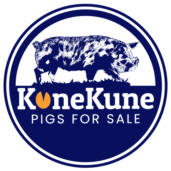KuneKune Pigs are the smallest purebred pig breed, known as the only true “miniature” pigs compared to larger commercial breeds. This article will examine the typical height and weight ranges of KuneKunes, factors that affect their size, their growth timeline from birth to full maturity, differences between male and female sizes, and how KuneKunes compare to other heritage and pet pig breeds in terms of size. Specifically, we will look at average height and weight, genetics, diet, environment, growth milestones, gender differences, and size comparisons to breeds like potbellied pigs and Juliana pigs.
In the realm of animals, KuneKune pigs stand out not only for their unique size but also for their amiable nature, making them a popular choice among pet lovers. Whether you are interested in KuneKune pigs for their pork production or as a pet KuneKune, understanding their size is crucial.
How Big Are KuneKunes in Terms of Height and Weight?
What is the Average Height for KuneKunes?
The average height range for KuneKunes is 18-24 inches (45-60 cm). Most adults fall within this range, though some larger males can be taller. The compact stature contributes to their “miniature pig” status compared to commercial breeds.
What is the Average Weight Range for KuneKunes?
- On average Female (Sows) KuneKune Pigs typically weigh 120 – 200 lbs (54.43 kg – 90.72 kg).
- On average Males (Boars) generally range from 200-240 lbs (90.72-108.86 kg), though some males may reach 400 lbs (181.43 kg).
Kunes are most known for their substantial body weight for their length, as to the meaning of KuneKune the Maori people named them for: “Fat and Round”.
What is the Common Body Shape and Appearance of KuneKunes?
KuneKunes have short, stocky legs that support their rotund, barrel-shaped body, giving them a rounded silhouette. Their broad, short, upturned snout and floppy, forward-facing ears also contribute to the breed’s distinctive appearance. KuneKunes display a range of coat colors including black, brown, ginger, gold, cream, spotted, or patched. The coat texture itself can vary from smooth to coarse, curly, or bristly. Some KuneKunes also have two small wattles (piri piri) hanging from their lower jaw. Their unique body shape and colorful coat patterns set KuneKunes apart from other heritage pig breeds.
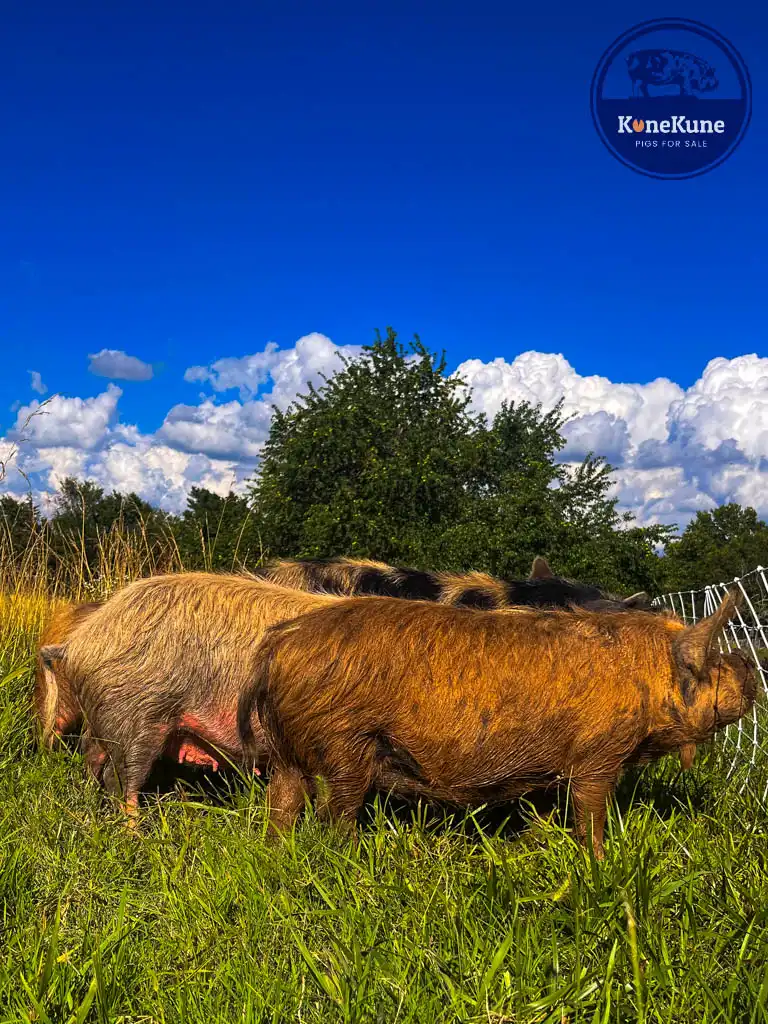
What Affects KuneKune Pig Size?
The genetics of KuneKunes play a significant role in their size, with some bloodlines tending towards more robust frames. This variability is also reflected in their fat distribution, which can influence their overall health and suitability for different purposes, whether it’s for meat production like pork or as beloved pet animals in homes.
When considering KuneKune pigs as pets, it’s important to note that their manageable size makes them a great option for pig enthusiasts who might not have space for larger breeds. The term ‘Pet KuneKune’ has gained popularity, reflecting their status as amiable companions rather than just farm animals.
How do Genetics Impact KuneKune Size?
The size of a KuneKune pig is primarily determined by its genetics and bloodlines while other environmental factors like diet are a minor factor. There are several genetic factors that influence KuneKune size:
Extension (E) Gene
- The Extension or E gene has four variations – Ed, E, ej, and e – that impact color and size
- The Ed gene produces the largest pigs while the e gene produces the smallest pigs
Agouti (A) Gene
- The Agouti or A gene modifies the base color produced by the E gene and comes in three forms – As, ay, and aw
- The As gene typically produces the largest pigs compared to ay and aw
Chinchilla (Ch) Gene
- The Chinchilla or Ch gene modifies color and reduces size slightly
- Pigs with the Ch gene tend to be a bit smaller than those without it
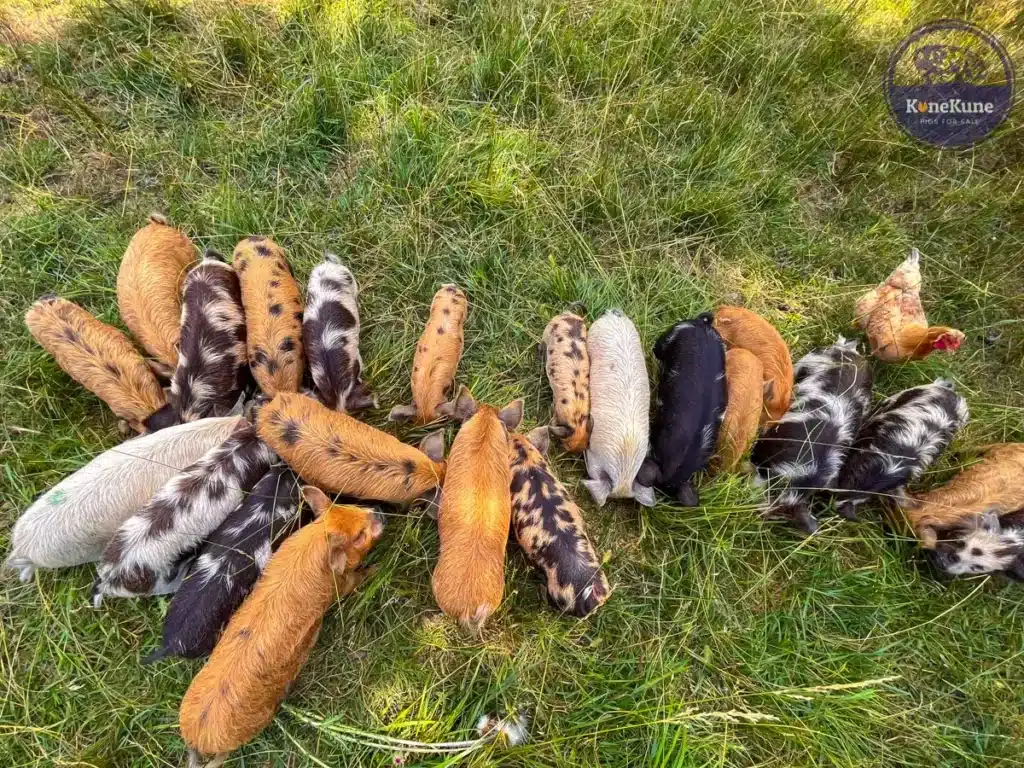
Rare Small Size Genes
Some rare genetic variations can produce exceptionally small KuneKunes, like the “micro pigs” advertised by some breeders. However please understand that these miniaturized lines often have health and fertility issues due to genetic flaws. They should never be sold as registered breeding stock and be sold to pet homes.
Does Diet Play a Role in KuneKune Pig Size?
Diet has a significant impact on KuneKune growth and adult size. KuneKunes are grazing pigs that can thrive on pasture alone if it is high-quality. However, most breeders provide balanced grain supplementation to ensure proper nutrition.
The protein level in feed greatly affects growth rate – most experts recommend a 16% protein or lower feed to prevent excess growth and obesity, as commercial pig feeds can be too high in protein. The amount of feed also matters, as overfeeding leads to obesity and underfeeding results in poor development. Feeding amounts should match the pig’s age, weighing around 2-4% of body weight per day.
Young, pregnant, and lactating KuneKunes need more feed and higher protein than adults on a maintenance diet. Some foods like excess grains, sugary treats and table scraps can also contribute to obesity. While genetics influence size, diet plays a key role in helping KuneKunes reach their growth potential and maintain good health.
A key aspect of KuneKune care is their diet, which predominantly consists of grass. These animals are efficient grazers, often thriving in environments where they can roam and feed on grass. This diet not only impacts their size but also contributes to their overall health and wellbeing.
Can Environment Influence KuneKune Size?
The environment can impact KuneKune growth and size. Pasture quality varies by season – grass loses nutrients in winter, so more feed supplementation may be needed then. Extreme heat or cold can affect appetite and growth. Crowded conditions and lack of exercise can lead to obesity. A clean, temperature controlled shelter is ideal. The amount of space to roam and graze also influences activity level and growth – more space provides exercise. Mud and muck contribute to hoof/leg issues that inhibit movement and grazing. KuneKunes are adaptable pigs, but poor environmental conditions will limit their genetic growth potential. Optimizing housing, space, grazing area, and feed/water access allows KuneKunes to thrive and achieve their ideal mature size.
What is the Growth Timeline for KuneKune Pigs?
How Much do KuneKune Piglets Grow in the First 6 Months?
Piglets typically weigh 1-3 lbs at birth. By 3 weeks they reach 6-10 lbs and by 8 weeks 15-20 lbs. Average daily gain is 0.5-0.65 lbs per day or 15-20 lbs per month. By 6 months of age, the average weight is around 90-110 lbs. Optimal feeding with adequate protein (16-18%) is important for growth in young KuneKunes under 1 year. Overfeeding can lead to excess fat, so appropriate feeding based on condition is recommended. With proper care and feeding, KuneKunes gain 0.5-0.65 lbs daily and reach 90-110 lbs by 6 months.
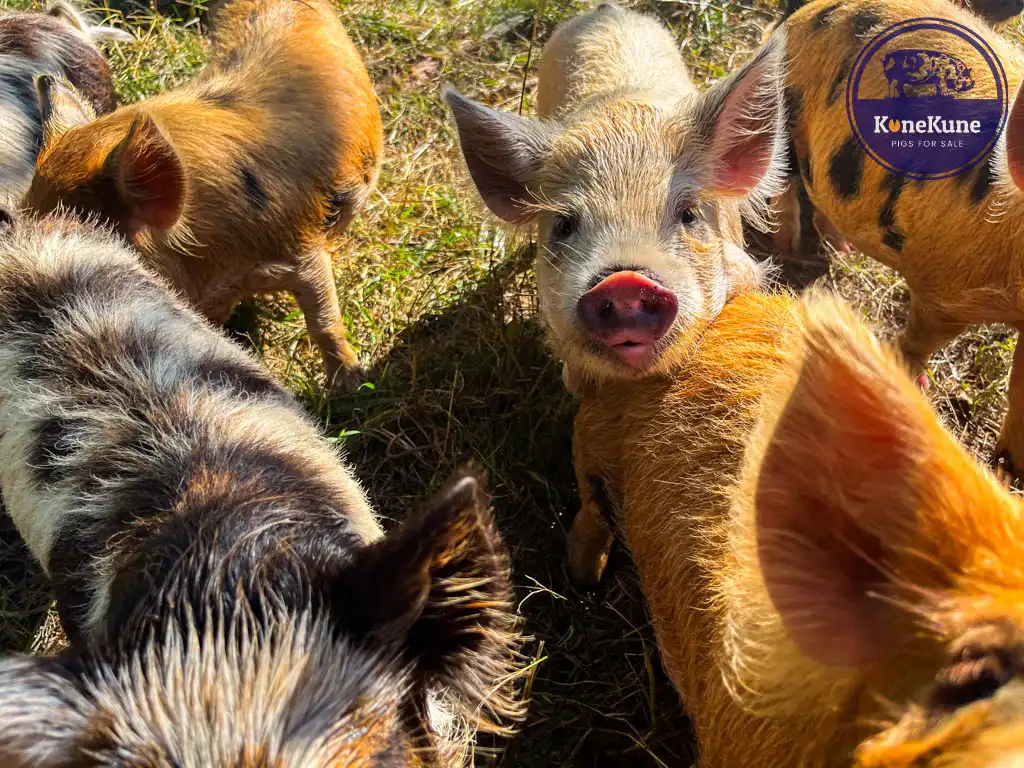
What is KuneKune Growth from 6 Months to 1 Year?
From 6 months to 1 year, KuneKunes continue steady growth, gaining 0.5-0.65 lbs daily or 15-20 lbs monthly. By 1 year, average weight is 180-210 lbs. Optimal protein for 6 months to 1 year is 16-18%. Overfeeding grain can lead to excess fat. Quality feed, pasture, and limited treats are recommended. Growth rate and feed intake vary individually. Adjusting feed to maintain ideal body condition is important. Gilts reach breeding weight between 12-18 months. Boars reach full fertility between 12-18 months. With proper care, KuneKunes gain 15-20 lbs monthly from 6 months to 1 year.
At What Age do KuneKunes Reach Full Adult Size?
KuneKunes are slow growing, taking 12-18 months to reach breeding weight and fertility. Most reach finished meat size around 12-15 months but still develop frame size until 2 years old. Maximum growth for bone, weight gain, and fat deposition is usually achieved between 2-3 years in KuneKunes. While they may be sexually mature or reach market weight earlier, their slow growth means full adult size is not achieved until 2-3 years old, compared to faster growing commercial breeds.
Are There Size Differences Between Male and Female KuneKunes?
Yes, there are clear size differences between male and female KuneKunes. As discussed previously, adult females average 100-175 lbs while males reach 200-250 lbs. Males can be 25% heavier than females. The height range for females is around 12-14 inches versus 14-16 inches for males. Males also have larger frames with broader shoulders and more mass. These size differences relate to the breeding roles – males need larger body size for protection and reproduction. The size dimorphism is common in livestock species.
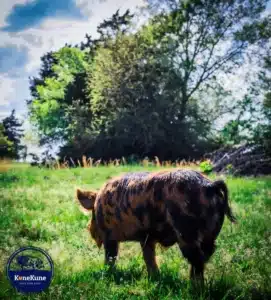
How Does Pet KuneKune Size Compare to Other Heritage Pig Breeds?
Compared to other heritage and pet pig breeds, KuneKunes are on the smaller end of the spectrum. Breeds like Large Blacks, Gloucestershire Old Spots, and Tamworths can reach 300-700 lbs. Mangalitsa pigs range from 200-500 lbs. Ossabaw Island hogs are 100-300 lbs. Potbellied pigs average 100-150 lbs but can be smaller “mini” sizes. Juliana and Gottingen minipigs weigh 60-150 lbs. KuneKunes are similar in size to the smaller end of Vietnamese Potbellied pigs and standard Juliana/Gottingen minipigs. Their petite size compared to other heritage breeds classifies them as a true “miniature” pig.
For an in-depth comparison of KuneKune traits versus other breeds, check out this article on KuneKune Pigs vs Other Heritage Breeds on the distinctive characteristics of KuneKunes.
But what makes Kunes special for pets isn’t necessarily their size but their demeanor. Originally from New Zealand, KuneKunes have a way of charming people with their friendly disposition. This is one reason more and more people are turning towards these gentle animals as pets. The way KuneKunes have adapted from their origins in New Zealand to various other parts of the world demonstrates their resilience and versatility.
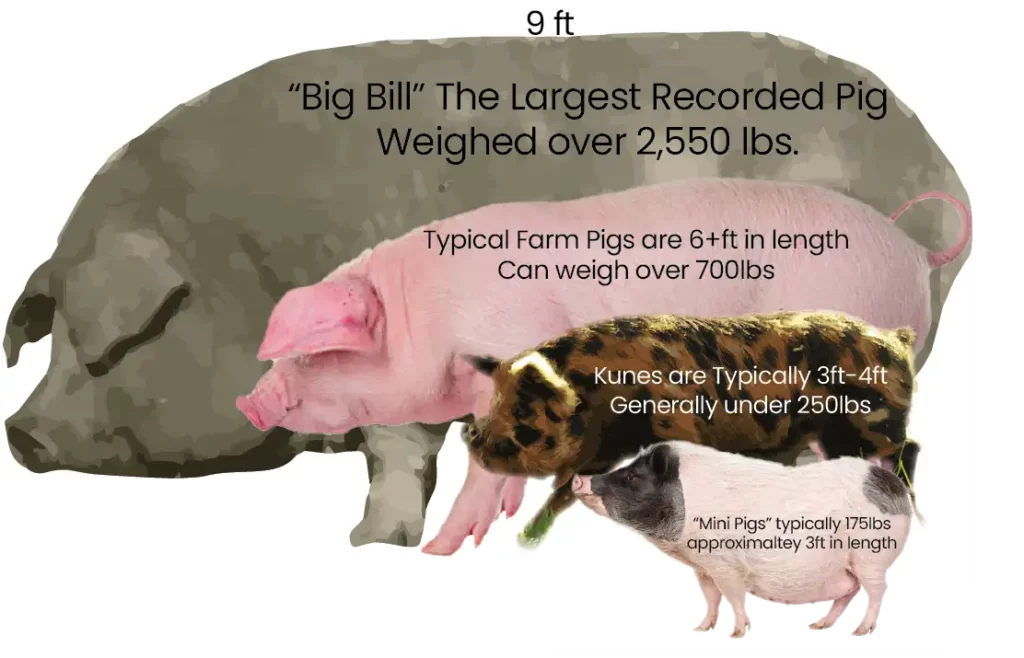
How Do KuneKune Heights and Weights Compare?
Typical height for a KuneKune is 14-24 inches and weight is 100-250 lbs for females and males respectively. Potbellied pigs have a similar height of 14-22 inches but are lighter at 100-150 lbs. Juliana and Gottingen minipigs are shorter at 14-19 inches in height but still weigh 60-150 lbs. Mangalitsas, Large Blacks, and other mid-sized heritage breeds are taller, ranging from 30-39 inches in height and 200-700 lbs in weight depending on sex. KuneKunes are the shortest breed but have a stocky build that gives them substantial weight for their petite height.
What Are the Appearance Differences?
Compared to other heritage breeds, KuneKunes have a very round, rotund body shape almost like a barrel on short legs giving them a distinct rounded silhouette. Their snout is very short and upturned. Large droopy ears frame their large head. Coat colors include black, brown, ginger, cream, spotted, patched. Other heritage breeds have more classic elongated hog shapes and erect ears. KuneKunes’ unique body shape, short snout, droopy ears and colorful coat patterns give them a strikingly different appearance compared to other heritage breeds’ characteristics.
Closing Thoughts
KuneKunes are fascinating animals, offering a unique combination of traits that make them ideal for a variety of roles – from traditional pig husbandry to becoming cherished members of the family as pet KuneKunes. Their size, diet, and friendly nature continue to endear them to people worldwide, making them more than just another breed of pigs.
What is the smallest size a KuneKune pig can be?
KuneKunes are typically in the size range discussed in this article, but there can be some variability in the breed. Very small females may be under 100 lbs full grown, while large males can reach over 400 lbs. Most certified breeding stock will fall within the expected size ranges.
What age do KuneKunes stop growing?
As mentioned in the growth timeline section, KuneKunes typically reach their full adult size between 2-3 years old. Their growth rate slows down after 12-18 months when they reach sexual maturity and breeder size.
How big will my KuneKune pig get?
The expected adult size will depend on the individual pig’s genetics, gender, diet, and environmental conditions during development. Reviewing the size of your pig’s parents and bloodline can give an indication of mature size, but their unique combination of factors will determine final adult stature. Monitoring growth rate can help estimate final size.
Should I worry if my KuneKune pig is much smaller or larger than average?
Some natural variation in size is normal, but significant deviation from expected ranges could indicate an underlying health/nutrition issue or improper breeding. Consult your veterinarian if concerned and adjust feed as needed. Extremes of very small or large may lower breeding suitability.
What health problems are related to KuneKune size?
Obesity is a main concern if KuneKunes are overfed or inactive. Joint issues can develop if very overweight. Underweight KuneKunes may lack proper nutrition. Optimal size supports good health – not too fat or thin. Proper diet and exercise prevent size-related issues.
